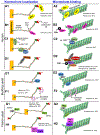Mapping the kinetochore MAP functions required for stabilizing microtubule attachments to chromosomes during metaphase
- PMID: 31454167
- PMCID: PMC7603900
- DOI: 10.1002/cm.21559
Mapping the kinetochore MAP functions required for stabilizing microtubule attachments to chromosomes during metaphase
Abstract
In mitosis, faithful chromosome segregation is orchestrated by the dynamic interactions between the spindle microtubules (MTs) emanating from the opposite poles and the kinetochores of the chromosomes. However, the precise mechanism that coordinates the coupling of the kinetochore components to dynamic MTs has been a long-standing question. Microtubule-associated proteins (MAPs) regulate MT nucleation and dynamics, MT-mediated transport and MT cross-linking in cells. During mitosis, MAPs play an essential role not only in determining spindle length, position, and orientation but also in facilitating robust kinetochore-microtubule (kMT) attachments by linking the kinetochores to spindle MTs efficiently. The stability of MTs imparted by the MAPs is critical to ensure accurate chromosome segregation. This review primarily focuses on the specific function of nonmotor kinetochore MAPs, their recruitment to kinetochores and their MT-binding properties. We also attempt to synthesize and strengthen our understanding of how these MAPs work in coordination with the kinetochore-bound Ndc80 complex (the key component at the MT-binding interface in metaphase and anaphase) to establish stable kMT attachments and control accurate chromosome segregation during mitosis.
Keywords: MAPs; Ndc80; chromosomes; kinetochores; microtubules; mitosis.
© 2019 Wiley Periodicals, Inc.
Conflict of interest statement
The authors declare no conflict of interest.
Figures


References
-
- Akhmanova A, Hoogenraad CC, Drabek K, Stepanova T, Dortland B, Verkerk T, Vermeulen W, Burgering BM, De Zeeuw CI, Grosveld F, and Galjart N. 2001. Clasps are CLIP-115 and -170 associating proteins involved in the regional regulation of microtubule dynamics in motile fibroblasts. Cell. 104:923–935. - PubMed
-
- Akhmanova A, and Steinmetz MO. 2008. Tracking the ends: a dynamic protein network controls the fate of microtubule tips. Nat Rev Mol Cell Biol. 9:309–322. - PubMed
-
- Akhmanova A, and Steinmetz MO. 2010. Microtubule +TIPs at a glance. J Cell Sci. 123:3415–3419. - PubMed
Publication types
MeSH terms
Substances
Grants and funding
LinkOut - more resources
Full Text Sources

